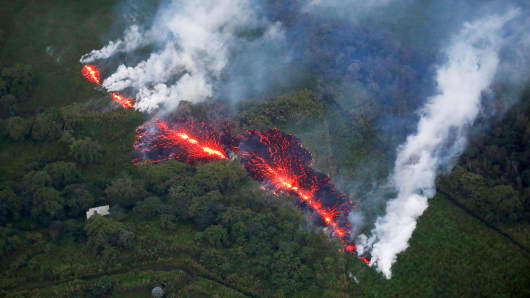A 17th fissure spewing lava from Hawaii’s Kilauea volcano formed in the southeast corner of the Big Island, officials said Sunday, raising anxieties as the state braces for potentially violent eruptions.
The new fissure, a crack in the ground allowing lava to pour out, comes as state and federal officials already warned residents in that corner of the island to be prepared to evacuate at a moment’s notice.
The fissure was spotted west of state Highway 132 and led state officials to call for some residents along Halekamahina Loop Road to leave their homes. Steam and lava spatter could be seen from the new fissure, officials said.
This newest fissure appeared at least several hundred yards long and was producing spatter rising “many tens of feet into the air,” the U.S. Geological Survey said.
The unsettling activity followed two other fissures initially announced Saturday by the USGS, although geologists later determined one of those fissures did not emit any lava so was not considered active. The USGS had said Sunday’s fissure was the 18th, but then relabeled it as No. 17.
The agency warned about the possibility of an explosive eruption at the volcano’s Halema’uma’u Crater because of the withdrawal of lava from the Kilauea summit lake.
“This could generate dangerous debris very near the crater and ashfalls up to tens of miles downwind,” the warning said.
The danger comes from the lava level that is dropping inside the volcano. If it falls below the water table, water will pour onto the lava, generating steam that will likely explode from the summit in a shower of rocks, ash and sulfur dioxide gases.
Boulders as big as refrigerators could be tossed a half-mile, and ash plumes could soar as high as 20,000 feet spread over a 12-mile area, according to the Hawaii Civil Defense.
Concerns have been mounting since the Kilauea erupted May 3, sending 2,200-degree lava bursting through cracks into backyards in the Leilani Estates neighborhood and destroying 36 structures, including 26 homes. As the magma shifted underground, a magnitude-6.9 earthquake also rocked the Big Island.
The fissure spotted Saturday produced a lava flow that traveled about 250 yards before stalling about 2:30 p.m., the geological survey said.
It opened in the vicinity of a geothermal energy plant, the agency said. Plant workers removed 50,000 gallons of pentane, a highly flammable solvent, stored at the site as a precaution last week.
On Friday, President Trump declared the Big Island a disaster area. The move will allow federal financial assistance for state and local governments as they repair roads, parks, schools and water pipes damaged by the eruption.
The Hawaii National Guard has prepared to use ground convoys and even helicopters to pluck hundreds of residents out of danger if necessary.
The Big Island, also known as the island of Hawaii, has a population of about 190,000 about 200 miles southeast of Oahu, the most-populous island and site of the state capital, Honolulu. The eruption on the Big Island is not affecting Oahu.
“We’ve got all the warning signs we need,” said Steve Brantley, deputy scientist-in-charge for the geological survey’s Hawaiian Volcano Observatory, the Honolulu Star-Advertiser reported. “There may not be any additional warning before the magma actually starts moving up to the surface.”
The biggest threat is to residents of the Lower Puna area, a southeast corner of the island, which could get blocked from evacuation routes if fissures cut Route 132.
The Civil Defense has warned lower Puna residents in the towns of Kapoho and Kalapana to stay alert for volcanic eruption and gas emissions and “be prepared to evacuate immediately.”
“Residents in lower Puna should remain informed and heed Hawaii County Civil Defense closures, warnings and messages,” the geological survey said.
The Hawaii National Guard is prepared, with only 90 minutes’ notice, to rescue 2,000 people in troop-carrying vehicles and Blackhawk or Chinook helicopters.
“We can move 226 people in one convoy. So we could move 226 at once with about an hour and a half notice, and we would drop them off somewhere. The vehicles could come back, and we would just do that round-robin,” Lt. Col. Shawn Tsuha told KHON-TV.
Conversations and discussions are being held on the C-VINE News Talk – Facebook Group Page. (Must be a Facebook member): C-VINE News Talk



